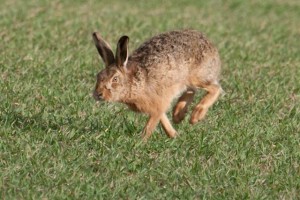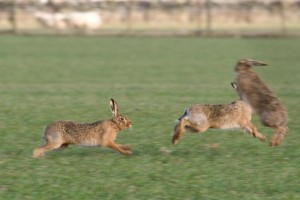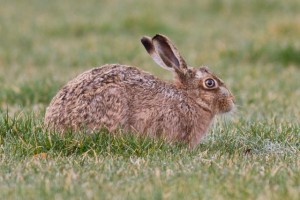Species profile – Brown hare (Lepus europaeus)
Montrose Basin is truly an extra special place for wildlife. You only have to look at the designations the site has to realise this. It is a Site of Special Scientific Interest (SSSI), a Ramsar site, a Special Protection Area (SPA), a Local Nature Reserve (LNR), a Scottish Wildlife Trust Reserve and the River South Esk reserve is a Special Area for Conservation (SAC).
A lot of people know the site as being a great place to watch birds, and the reserve has been described by the BBC as “a birdwatcher’s utopia”[1], but there is so much more to this fabulous haven for nature than just birds.
This is why for my first species profile I have decided not to concentrate on a bird species, but to go for something a little bit furrier…the brown hare.

A member of the lagomorph family which includes mountain hares and rabbits, brown hares can be found across Britain and on our reserve at Montrose we have a small population of around fifty, which is mostly confined to the mixed agricultural land at the western end of the reserve where they survive on a diet of grasses and cereals. They will, however, also feed on the salt marsh at the edge of the Basin and have even been known to venture out on the mud at low tide to feed on seaweeds.
Considered by many as a native mammal, brown hares were actually introduced to Britain by the Romans as a source of food, mountain hares are the only native lagomorphs found in Britain.
During the mating season females can often show their displeasure with a male who is paying her too much unwanted attention by fighting him using her front paws, an act known as boxing and which gets hares the reputation of being “mad March hares”.

After about five or six weeks of pregnancy, the female will give birth to a litter of between 4-6 young, known as leverets. The young are born in a grassy depression referred to as a form, not in a burrow like rabbits, and as soon as she has given birth the female can mate again, allowing her to have up to four litters in a single season.
When they are born, the leverets are already covered in fur, their eyes are open and for the first month of their lives the only contact they will have with their mother is at dusk when she feeds them for around 10-15 minutes. Once she has finished feeding her litter, the mother will lick her young and eat their waste in an effort to remove any smells which may give their presence away to a predator such as a fox.
Taking a walk on the Mains of Dun, especially during the early morning or evening, is often rewarded by fantastic views of this shy, charismatic and alluring mammal. I often see hares while out on the reserve and have been lucky enough to witness boxing hares on several occasions. It is thoroughly entertaining stuff, no wonder it is considered one of the top wildlife spectacles in Britain[2].
It is quite easy to tell the difference between a rabbit and a brown hare when in the countryside. Brown hares:
- are much larger;
- have a reddish tinge to their fur;
- have larger ears which have black tips;
- have large yellow eyes;
- do not live in burrows.

A few other facts about brown hares:
- They can reach speeds of up to 45 mph.
- Brown hares can swim, I didn’t realise this until I witnessed it myself when I saw a brown hare crossing a drainage ditch at high tide on the reserve.
- They normally weigh about 3-4 kilograms, although big males can weight up to 5 or 6 kilos.
- Foxes, changes in agriculture and poaching are the main threats to brown hares in Scotland.
Adam – Montrose Basin Ranger
[1] http://www.bbc.co.uk/naturescalendar/winter/wetlands/montrose_basin/montrose_access.shtml
[2] Dilger, M. 2008. Britain’s Best Wildlife. HarperCollins Publishers Ltd.
Help protect Scotland’s wildlife
Our work to save Scotland’s wildlife is made possible thanks to the generosity of our members and supporters.
Join today from just £3 a month to help protect the species you love.
Preface
Montrose Basin is truly an extra special place for wildlife. You only have to look at the designations the site has to realise this. It is a Site of Special …
